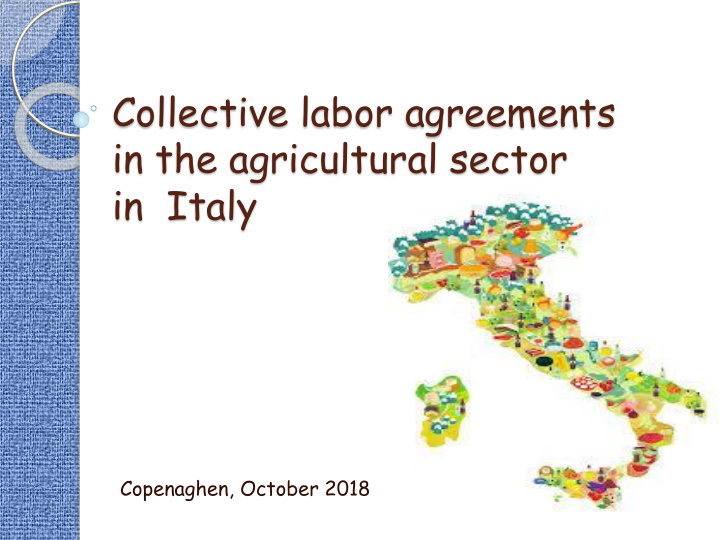



Collective labor agreements in the agricultural sector in Italy Copenaghen, October 2018
CCNL operai agricoli National collective labor contract for agricultural workers CCNL impiegati agricoli National collective labor contract for agriculture clerks CCNL dirigenti agricoli National collective labor contract for agricultural managers
Content of the collective agreement • Obligatory content (contract duration and renewal procedures, collective agreements structure, obligations for stipulating organizations) • Regulatory content (discipline of the work contract and economic aspects) 3
level of the collective agreement (agriculture workers) • National level • Provincial level ( decentralization) 4
Rules of the collective agreement • Duration 4 years • Wage increases 2 years 5
National level (agriculture workers) • general contract • work contract types • general rules on working time • holidays, leave, protections • health and safety at work • training of workers • bilateralism (entities jointly managed) • minimum salary • general classification (3 areas) • trade union rights • other subjects assigned by law • matters of provincial contracts 6
Provincial level (agriculture workers) Matters decided by the national contract: • distribution of working working time • specific classification (levels and professional tasks) • salary for each level • productivity bonuses • bilateralism (entities jointly managed) 7
level of the collective agreement (agriculture clercks) • National level • Regional level 8
level of the collective agreement (agriculture managers) • National level 9
Legal scope of collective agreements in Italy
under the fascist regime and until 1944 Employers’ and employee’ unions were public subjects The agreements they signed were imposed erga omnes (to all) on employers and employees of one economic sector
after 1948, when Italy became a republic negotiated agreements have been considered in the area of private autonomy the organizations that stipulate collective agreements are private associations
indeed, Italian Constitution has laid down the possibility for collective agreements to be applied erga omnes But this procedure is very complex and has never been used
private-law agreement collective agreements only apply to the employers that belong to the signatory employers’ organization and only benefit the employees that belong to the signatory trade union
however during the years jurisprudence and bills have tried to extend collective agreement scope beyond its natural capacity
according to Supreme Civil Court’s jurisprudence: 1. the employer that belongs to the signatory employers’ organization must apply the agreement to his whole staff (principle of equal working conditions)
according to Supreme Civil Court’s jurisprudence: 2. the employer that does not belong to the employers’ organizations is in any case bound by collective agreement, if he in actual fact applies the collective agreement in whole or in part ( expressed or implicit adhesion )
according to Supreme Civil Court’s jurisprudence: 3. sector collective agreements are used like correct parameters in sentences (enough and proportioned salary)
incentives to apply collective agreements fixed by specific state bills financial aids or fiscal and social contribution facilities are only assigned to employers who apply to whole staff a working condition at least comparable to sector collective agreement rules
The most representative collective agreement - by law - is considered the minimum basis for social security contributions
Open questions - Plurality of collective agreements - Respondence to business needs / salary linked to productivity - Modernization: towards company contracts?
thank you for your attention
Recommend
More recommend